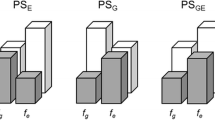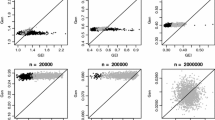Abstract
Gene–environment (G × E) interactions have been invoked to account, at least in part, for the gap between the known heritability of common human diseases and the phenotypic variation hitherto explained by genetic variants. Noteworthy in this context, a case-only (CO) design has been proposed in the past as a means to detect G × E interactions possibly more efficiently than by using classical case–control and cohort designs. So far, however, most CO studies have followed a candidate (or single) gene approach, and the genome-wide utility of the CO design is still more or less unknown. In particular, the way in which linkage disequilibrium (LD) impacts upon the chance to detect G × E interaction through the analysis of proxy markers has not been studied in much detail before. Therefore, we systematically assessed the power to indirectly detect a given G × E interaction through exploiting LD in a CO design. Our simulations revealed a strong relationship between LD and detection power that was subsequently validated in a real colorectal cancer data set.






Similar content being viewed by others
References
Albert PS, Ratnasinghe D, Tangrea J, Wacholder S (2001) Limitations of the case-only design for identifying gene–environment interactions. Am J Epidemiol 154:687–693
Bhattacharjee S, Wang Z, Ciampa J, Kraft P, Chanock S, Chatterjee N (2010) Using principal components of genetic variation for robust and powerful detection of gene–gene interactions in case–control and case-only studies. Am J Hum Genet 86:331–342
Cordell HJ (2002) Epistasis: what it means, what it doesn’t mean, and statistical methods to detect it in humans. Hum Mol Genet 11:2463–2468
Dennis J, Hawken S, Krewski D, Birkett N, Gheorghe M, Frei J, McKeown-Eyssen G, Little J (2011) Bias in the case-only design applied to studies of gene–environment and gene–gene interaction: a systematic review and meta-analysis. Int J Epidemiol 40:1329–1341
Ege MJ, Strachan DP, Cookson WO, Moffatt MF, Gut I, Lathrop M, Kabesch M, Genuneit J, Buchele G, Sozanska B, Boznanski A, Cullinan P, Horak E, Bieli C, Braun-Fahrlander C, Heederik D, von Mutius E (2011) Gene–environment interaction for childhood asthma and exposure to farming in Central Europe. J Allergy Clin Immunol 127:138–144
Franks PW (2011) Gene × environment interactions in type 2 diabetes. Curr Diab Rep 11:552–561
Gatto NM, Campbell UB, Rundle AG, Ahsan H (2004) Further development of the case-only design for assessing gene–environment interaction: evaluation of and adjustment for bias. Int J Epidemiol 33:1014–1024
Gauderman WJ (2002) Sample size requirements for association studies of gene–gene interaction. Am J Epidemiol 155:478–484
Greenland S (2009) Interactions in epidemiology: relevance, identification, and estimation. Epidemiology 20:14–17
Hamza TH, Chen H, Hill-Burns EM, Rhodes SL, Montimurro J, Kay DM, Tenesa A, Kusel VI, Sheehan P, Eaaswarkhanth M, Yearout D, Samii A, Roberts JW, Agarwal P, Bordelon Y, Park Y, Wang L, Gao J, Vance JM, Kendler KS, Bacanu SA, Scott WK, Ritz B, Nutt J, Factor SA, Zabetian CP, Payami H (2011) Genome-wide gene–environment study identifies glutamate receptor gene GRIN2A as a Parkinson’s disease modifier gene via interaction with coffee. PLoS Genet 7:e1002237
Hunter DJ (2005) Gene–environment interactions in human diseases. Nat Rev Genet 6:287–298
Kraft P, Yen YC, Stram DO, Morrison J, Gauderman WJ (2007) Exploiting gene–environment interaction to detect genetic associations. Hum Hered 63:111–119
Krawczak M, Nikolaus S, von Eberstein H, Croucher PJ, El Mokhtari NE, Schreiber S (2006) PopGen: population-based recruitment of patients and controls for the analysis of complex genotype–phenotype relationships. Community Genet 9:55–61
Lettre G, Lange C, Hirschhorn JN (2007) Genetic model testing and statistical power in population-based association studies of quantitative traits. Genet Epidemiol 31:358–362
Lewontin RC, Kojima K (1960) The evolutionary dynamics of complex polymorphisms. Evolution 14:458–472
Manolio TA, Collins FS, Cox NJ, Goldstein DB, Hindorff LA, Hunter DJ, McCarthy MI, Ramos EM, Cardon LR, Chakravarti A, Cho JH, Guttmacher AE, Kong A, Kruglyak L, Mardis E, Rotimi CN, Slatkin M, Valle D, Whittemore AS, Boehnke M, Clark AG, Eichler EE, Gibson G, Haines JL, Mackay TF, McCarroll SA, Visscher PM (2009) Finding the missing heritability of complex diseases. Nature 461:747–753
Montana G (2005) HapSim: a simulation tool for generating haplotype data with pre-specified allele frequencies and LD coefficients. Bioinformatics 21:4309–4311
Phillips PC (1998) The language of gene interaction. Genetics 149:1167–1171
Piegorsch WW, Weinberg CR, Taylor JA (1994) Non-hierarchical logistic models and case-only designs for assessing susceptibility in population-based case–control studies. Stat Med 13:153–162
Purcell S, Neale B, Todd-Brown K, Thomas L, Ferreira MA, Bender D, Maller J, Sklar P, de Bakker PIW, Daly MJ, Sham PC (2007) PLINK: a tool set for whole-genome association and population-based linkage analyses. Am J Hum Genet 81:559–575
Rothman K, Greenland S, Lash T (2008) Modern Epidemiology, 3rd edn. Lippincott Williams & Wilkins, Philadephia
Saunders CL, Gooptu C, Bishop DT, Barrett JH (2001) The use of case-only studies for the detection of interactions, and the non-independence of genetic and environmental risk factors for disease (Abstract). Genet Epidemiol 21:174
Siegert S, Hampe J, Schafmayer C, von Schönfels W, Egberts JH, Försti A, Chen B, Lascorz J, Hemminki K, Franke A, Nothnagel M, Nöthlings U, Krawczak M (2013) Genome-wide investigation of gene–environment interactions in colorectal cancer. Hum Genet 132:219–231
Siemiatycki J, Thomas DC (1981) Biological models and statistical interactions: an example from multistage carcinogenesis. Int J Epidemiol 10:383–387
Thomas D (2010) Gene–environment-wide association studies: emerging approaches. Nature Rev Genet 11:259–272
Thompson WD (1991) Effect modification and the limits of biological inference from epidemiologic data. J Clin Epidemiol 44:221–232
Vercelli D (2010) Gene–environment interactions in asthma and allergy: the end of the beginning? Curr Opin Allergy Clin Immunol 10:145–148
Wang S, Zhao H (2003) Sample size needed to detect gene–gene interactions using association designs. Am J Epidemiol 158:899–914
Wang X, Elston R, Zhu X (2010) The meaning of interaction. Hum Hered 70:269–277
Wu C, Hu Z, He Z, Jia W, Wang F, Zhou Y, Liu Z, Zhan Q, Liu Y, Yu D, Zhai K, Chang J, Qiao Y, Jin G, Liu Z, Shen Y, Guo C, Fu J, Miao X, Tan W, Shen H, Ke Y, Zeng Y, Wu T, Lin D (2011) Genome-wide association study identifies three new susceptibility loci for esophageal squamous-cell carcinoma in Chinese populations. Nat Genet 43:679–684
Yang Q, Khoury MJ (1997) Evolving methods in genetic epidemiology. III. Gene–environment interaction in epidemiologic research. Epidemiol Rev 19:33–43
Yang Q, Khoury MJ, Flanders WD (1997) Sample size requirements in case-only designs to detect gene–environment interaction. Am J Epidemiol 146:713–720
Acknowledgments
This study was carried out as part of the Research Training Group ‘Genes, Environment and Inflammation’, supported by the Deutsche Forschungsgemeinschaft (GRK 1743). Additional funding was provided by Research Area XI (‘Epidemiology’) of the Excellence Cluster ‘Inflammation at Interfaces’. The colorectal cancer dataset was obtained from the PopGen Biobank Kiel, which is supported by the State of Schleswig-Holstein and the German Federal Ministry of Education and Research (grant 01EY1103 to the PopGen 2.0 Network).
Conflict of interest
The authors declare that there is no conflict of interest.
Author information
Authors and Affiliations
Corresponding author
Appendix: Estimating the level of G × E interaction in case-only studies
Appendix: Estimating the level of G × E interaction in case-only studies
ORs for the joint effect of G and E and for the marginal effects of G and E are calculated as follows (adapted from Gatto et al. 2004; see “Materials and methods” of the main text for definitions):
Joint effect of G and E | Marginal effect of G (given E = 0) | Marginal effect of E (given G = 0) | ||||||
|---|---|---|---|---|---|---|---|---|
D = 1 | D = 0 | D = 1 | D = 0 | D = 1 | D = 0 | |||
G = 1, E = 1 | a 1 | b 1 | G = 1 | c1 | d 1 | E = 1 | a 2 | b 2 |
G = 0, E = 0 | c 2 | d 2 | G = 0 | c2 | d 2 | E = 0 | c 2 | d 2 |
\({\text{OR}}_{\text{GE}} = \frac{{a_{ 1} /b_{1} }}{{c_{2} /d_{2} }}\) | \({\text{OR}}_{G} = \frac{{c_{1} /d_{1} }}{{c_{2} /d_{2} }}\) | \({\text{OR}}_{E} = \frac{{a_{2} /b_{2} }}{{c_{2} /d_{2} }}\) | ||||||
Cases (D = 1) | Controls (D = 0) | ||||
|---|---|---|---|---|---|
G = 1 | G = 0 | G = 1 | G = 0 | ||
E = 1 | a 1 | a 2 | E = 1 | b 1 | b 2 |
E = 0 | c 1 | c 2 | E = 0 | d 1 | d 2 |
\(G - E {\text{ OR}}_{\text{cases}} = \frac{{a_{1} /a_{2} }}{{c_{1} /c_{2} }}\) | \(G - E {\text{ OR}}_{\text{controls}} = \frac{{b_{1} /b_{2} }}{{d_{1} /d_{2} }}\) | ||||
Term 1 | Term 2 | ||||
Conceptually, multiplicative interaction between G and E (G × E OR) refers to any deviation of the product of OR G and OR E from ORGE. Therefore, substituting ORGE, OR G and OR G by the respective terms yields
Under the assumptions that G and E are independent in the general population and that the disease is rare (i.e. that controls are almost representative of the population as a whole), Term II will be equal to 1. Then, G × E OR can be estimated by the gene environment OR in cases (see Piegorsch et al. 1994 for further details).
Rights and permissions
About this article
Cite this article
Yadav, P., Freitag-Wolf, S., Lieb, W. et al. The role of linkage disequilibrium in case-only studies of gene–environment interactions. Hum Genet 134, 89–96 (2015). https://doi.org/10.1007/s00439-014-1497-2
Received:
Accepted:
Published:
Issue Date:
DOI: https://doi.org/10.1007/s00439-014-1497-2




